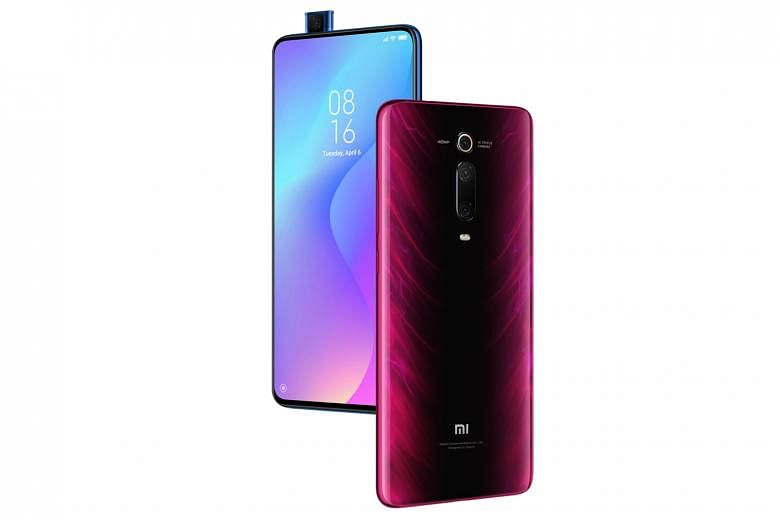Last year's Xiaomi Pocophone F1 offered flagship-class performance at an unbeatable price of $449.
It is looking likely that there will not be a second Pocophone, but the recently launched Xiaomi Mi 9T, also known as the Redmi K20 in some markets, is seen as the spiritual sequel. It even starts at the same $449 price point in Singapore.
The Mi 9T, however, offers significant upgrades across the board: better triple rear cameras; an Oled screen; a trendy glass back with a shimmery holographic finish; and support for near-field communication (NFC).
But unlike the Pocophone, the 9T cannot boast of having the best performance. It uses a Qualcomm Snapdragon 730 processor, which is a tier lower than the flagship Snapdragon 855 chip. It feels fast enough to me, with mobile games running smoothly.
It also lacks a microSD card slot, so avid gamers and videographers may want to pick the 128GB model ($499) over the 64GB version. Other flagship features that are not in the mid-range 9T include wireless charging and water resistance.
The Mi 9T offers an all-screen experience with minimal bezels. Instead of having a notch for the front camera, a small motorised camera pops up from within the chassis - complete with flashing lights and a ringtone - when you need to take a selfie.
It takes this 20-megapixel (MP) camera more than a second to emerge, but more importantly, it is much faster to retract and avoid possible damage when the phone is dropped.
By default, a beauty filter erases your acne scars and wrinkles, but you can disable it for a more natural-looking photo. The Portrait mode blurs the background while keeping your face in focus. There is no depth sensor, so this bokeh effect is generated by software, which occasionally results in some artifacts.
It has three rear cameras, headlined by a 48MP primary camera that uses the same Sony sensor found in many phones this year. The other cameras are an ultra-wide angle camera and a telephoto camera that offers 2x optical zoom.

-
FOR
• Takes great photos in well-lit conditions
• Bright Oled screen with HDR support
• Minimal bezels without a notch
• Good battery life
-
AGAINST
• Low-light camera performance is mediocre
-
SPECS
PRICE: $449
PROCESSOR: Qualcomm Snapdragon 730 (Dual-core 2.2GHz, hexa-core 1.8GHz)
DISPLAY: 6.39-inch, Amoled, 2,340 x 1,080 pixels, 403 ppi pixel density
OPERATING SYSTEM: Android 9.0
MEMORY: 64GB, 6GB RAM
REAR CAMERAS: 48MP (f/1.75), 13MP ultra-wide (f/2.4, 124-degree), 8MP telephoto (f/2.4)
FRONT CAMERA: 20MP (f/2.2)
BATTERY: Non-removable 4,000mAh battery
-
RATING
FEATURES: 4/5
DESIGN: 4/5
PERFORMANCE: 4/5
VALUE FOR MONEY: 5/5
BATTERY LIFE: 5/5
OVERALL: 4.5/5
While you can shoot 48MP photos, I recommend the default 12MP mode, which produces sharp and detailed photos in well-lit conditions.
It is less impressive at night photography. A long-exposure Night mode helps to brighten photos sufficiently to be usable, even when shooting handheld. But in most of my night shots, there is plenty of noise, along with a loss of detail when zoomed in.
Its bright Oled screen supports HDR (High Dynamic Range) videos from Netflix and YouTube that look vibrant and realistic, a feature usually found in flagship phones. Those top models, though, have a higher-resolution display than the full-HD screen on the 9T.
Like other near-bezel-less phones, it comes with an in-display fingerprint sensor. It is not the fastest I have tried, but it is accurate most of the time.
The audio from the bottom-firing speaker can be rather loud, as long as you do not cover it with your palm while holding the phone. A 3.5mm audio jack is at the top of the phone.
Despite the improvements over the years, I am still not the biggest fan of Xiaomi MIUI interface. The latest MIUI 10, which is based on Android 9, is much cleaner and less bloated than previous versions.
I also prefer Xiaomi's full-screen gestures - which replace the usual Android navigation buttons - over other implementations.
In any case, it was simple enough to download a third-party app, such as the popular Nova Launcher, to customise the look and feel of the interface to my taste.
Its 4,000mAh battery is identical in capacity to the Pocophone's. It is good enough to last me comfortably through the day, even with some mobile gaming on the side. In the usual video-loop battery test, the 9T clocked an impressive 16hr 43min with its screen brightness set to maximum.


